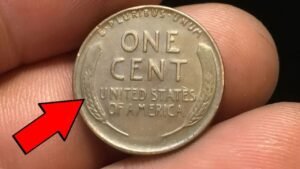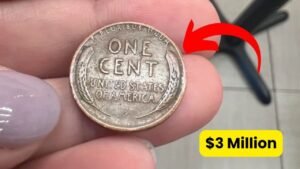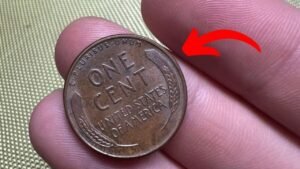you’re sifting through your loose change, and there it is—a small, unassuming penny that could be worth millions. The Lincoln Wheat Penny, a coin with a storied past, has sparked treasure hunts across America. In 2025, rumors are swirling about a rare edition that could still be hiding in your pocket. Let’s dive into the thrilling world of this iconic coin and uncover why it’s the talk of collectors everywhere!
The Fascinating History of the Lincoln Wheat Penny
The Lincoln Wheat Penny, minted from 1909 to 1958, is more than just pocket change—it’s a piece of American history. Designed by Victor David Brenner to honor Abraham Lincoln’s 100th birthday, it was the first U.S. coin to feature a real person’s portrait, replacing the traditional Lady Liberty. The reverse, with its two wheat stalks symbolizing prosperity, gave the coin its nickname, “Wheat Penny.” Over the years, this humble cent has become a collector’s dream, with certain rare editions fetching jaw-dropping prices at auctions.
Why the Wheat Penny Captivates Collectors
What makes the Lincoln Wheat Penny so special? It’s all about rarity, history, and a dash of serendipity. The coin’s design, with Lincoln’s stoic profile and the elegant wheat stalks, is instantly recognizable. But it’s the rare variations—minting errors, low-mintage years, and unique compositions—that turn these pennies into treasures.
For instance, the 1943 copper penny, accidentally struck during World War II when pennies were made of steel, has sold for over $1.7 million at auction. The allure of finding such a coin in circulation keeps collectors and casual enthusiasts alike on the edge of their seats.
The 2025 Buzz: A Penny Worth Millions?
In 2025, the Lincoln Wheat Penny is making headlines again, with whispers of ultra-rare editions potentially worth millions. While some claims—like a penny valued at $220 million—are likely exaggerated, the excitement is real. The 1943 bronze penny, the 1909-S VDB, and other key dates continue to fuel the frenzy. Could a newly discovered error coin or a pristine example from a low-mintage year break records this year? The possibility is enough to make anyone check their change twice
Key Dates and Variations to Watch For
Not all Wheat Pennies are created equal. Certain years, mint marks, and errors make some coins exponentially more valuable. Here’s a rundown of the most sought-after Lincoln Wheat Pennies that could turn your pocket change into a fortune.
The Legendary 1943 Copper Penny
During World War II, copper was scarce, so the U.S. Mint switched to zinc-coated steel for pennies in 1943. However, a tiny number of copper planchets from 1942 were accidentally used, creating the ultra-rare 1943 bronze penny. Fewer than 20 are known to exist, and one sold for $840,000 in 2023. If you find a 1943 penny that isn’t silver-colored, it could be a bronze error worth a fortune.
Other Notable 1943 Errors
The 1943-D bronze penny, minted in Denver, is another holy grail for collectors. With only a handful known, it’s valued at up to $250,000 or more. Also, keep an eye out for 1943 pennies with double-die errors, where the date or inscriptions appear doubled, adding significant value.
The 1909-S VDB: A Collector’s Classic
The 1909-S VDB penny, minted in San Francisco with Victor David Brenner’s initials on the reverse, had a low mintage of just 484,000. Collectors hoarded these coins early, making them rare in circulated condition. A red, uncirculated 1909-S VDB can fetch up to $168,000. Even in brown or red-brown hues, these coins command prices between $10,000 and $19,200.
The 1922 No D Penny
Minted in Denver, the 1922 No D penny is a quirky error where the mint mark was omitted due to a worn die. This anomaly makes it a favorite among collectors, with high-grade examples selling for tens of thousands. Its scarcity and unique story add to its appeal.
The 1914-D: A Low-Mintage Gem
With a mintage of just 1.2 million, the 1914-D penny is a scarce find. Compared to the 70 million pennies minted in Philadelphia that year, the Denver version is a collector’s prize, especially in uncirculated condition. Prices for high-grade examples can reach $50,000 or more.
How to Spot a Valuable Lincoln Wheat Penny
Finding a rare Wheat Penny isn’t just luck—it’s about knowing what to look for. Here’s a step-by-step guide to spotting a potential treasure in your change jar.
Check the Date and Mint Mark
The date is your first clue. Key years like 1909, 1914, 1922, 1931, and 1943 are prime candidates for high value. Next, check the mint mark, usually found below the date. An “S” (San Francisco) or “D” (Denver) can indicate rarity, while no mint mark means it was minted in Philadelphia. For example, the 1909-S VDB and 1914-D are far more valuable than their Philadelphia counterparts.
Look for Minting Errors
Errors like double-die obverses (where text or images appear doubled) or missing mint marks can skyrocket a coin’s value. The 1943 copper penny and 1922 No D are classic examples of errors that collectors covet. Use a magnifying glass or loupe to inspect for these anomalies.
Assess the Condition
Condition is king in coin collecting. Uncirculated or mint-state coins (graded MS65 or higher) fetch the highest prices. Look for coins with sharp details, minimal wear, and a natural patina. Red-colored pennies, which retain their original copper luster, are especially valuable.
Verify the Material
Most 1943 pennies are steel, but a copper or bronze version is a rare find. Use a magnet—if the penny doesn’t stick, it could be a valuable copper error. Similarly, the 1944 steel penny, struck on leftover steel planchets, is worth $75,000 to $125,000.
Where to Find These Hidden Treasures
The thrill of the hunt is what makes Wheat Penny collecting so exciting. While finding a million-dollar penny in circulation is unlikely, it’s not impossible. Here are the best places to start your search.
Pocket Change and Coin Rolls
Believe it or not, rare Wheat Pennies can still turn up in everyday change. Check your pocket change, especially at stores or in old coin jars. Banks often sell rolls of pennies, which can contain older coins. Be patient—sifting through rolls is a labor of love for collectors.
Estate Sales and Flea Markets
Inherited coin collections at estate sales or flea markets are goldmines for Wheat Pennies. Many families don’t realize the value of old coins, so you might snag a rare find for a bargain.
Online Auctions and Coin Shows
Platforms like eBay or Heritage Auctions are great for finding Wheat Pennies, though you’ll pay a premium for authenticated coins. Local coin shows are another hotspot, where you can meet dealers and get expert advice.
Caring for Your Wheat Penny Collection
If you’re lucky enough to find a potential treasure, proper care is crucial to preserve its value. Here’s how to keep your coins in top condition.
Storage Tips
Store coins in a cool, dry place using acid-free holders or albums designed for coins. Avoid plastic bags or containers that can trap moisture, leading to tarnishing or corrosion.
Handling Do’s and Don’ts
Never clean your coins—cleaning can scratch the surface and reduce value. Handle coins by the edges to avoid transferring oils from your skin. If you suspect a coin is valuable, store it carefully and seek professional authentication.
Authentication and Appraisal
If you think you’ve found a rare penny, have it appraised by a reputable numismatist or grading service like the Professional Coin Grading Service (PCGS) or Numismatic Guaranty Company (NGC). They’ll verify authenticity and grade the coin, which can significantly affect its value.
The 2025 Market: Will Prices Soar?
The rare coin market is buzzing in 2025, driven by inflation and renewed interest in tangible investments. Experts predict that high-grade Wheat Pennies, especially error coins like the 1943 bronze, could see record-breaking sales this year. While claims of pennies worth $46 million or more are likely sensationalized, a pristine 1943 copper penny could still fetch seven figures. The combination of historical significance, rarity, and collector demand makes these coins a hot commodity.
Busting Common Myths
The Wheat Penny world is full of myths. Not all Wheat Pennies are valuable—most are worth just a few cents. Cleaning doesn’t increase value; it often decreases it. And while rare pennies can still be found in circulation, it’s exceedingly rare. Most 1943 pennies are steel, not copper, so don’t get your hopes up without checking.
Most Valuable Lincoln Wheat Pennies in 2025
| Year | Mint Mark | Error/Variety | Estimated Value | Key Features |
|---|---|---|---|---|
| 1943 | None/D | Copper/Bronze | $250,000–$1.7M | Rare copper error during steel production |
| 1909 | S | VDB | $10,000–$168,000 | Low mintage, designer’s initials |
| 1922 | None | No D | $10,000–$50,000 | Missing mint mark error |
| 1914 | D | Standard | $2,000–$50,000 | Low mintage |
| 1944 | None | Steel | $75,000–$125,000 | Rare steel error |
Conclusion
The Lincoln Wheat Penny is more than a coin—it’s a treasure hunt wrapped in history. From the 1943 copper penny to the 1909-S VDB, these coins tell stories of wartime errors, artistic ambition, and collector passion. In 2025, the dream of finding a million-dollar penny keeps the excitement alive. So, grab a magnifying glass, check your change, and join the hunt. Who knows? Your next penny could be a life-changer!
FAQs: Your Guide to Lincoln Wheat Pennies in 2025
What makes a Lincoln Wheat Penny valuable in 2025?
Rarity, condition, and minting errors drive value. Key dates like 1909-S VDB, 1914-D, and 1943 copper pennies are especially prized due to low mintage or errors. Uncirculated coins in red condition fetch the highest prices.
How can I tell if my 1943 penny is copper?
Use a magnet. Steel pennies stick; copper or bronze ones don’t. If it’s non-magnetic, have it authenticated by a professional, as it could be worth hundreds of thousands.
Where can I find rare Wheat Pennies?
Check pocket change, coin rolls from banks, estate sales, flea markets, or online auctions. Coin shows are also great for finding rare coins and getting expert advice.
Should I clean my Wheat Pennies?
No! Cleaning can damage the surface and reduce value. Handle coins by the edges and store them in acid-free holders to preserve their condition.
How do I get my Wheat Penny appraised?
Contact a reputable numismatist or grading service like PCGS or NGC. They’ll assess authenticity, condition, and market value, ensuring you know your coin’s worth.
Are all Wheat Pennies valuable?
No, most are worth just a few cents. Only specific years, mint marks, or errors—like the 1943 bronze or 1909-S VDB—are highly valuable. Condition is also critical.
What’s the most expensive Wheat Penny ever sold?
A 1943-D bronze penny sold for $840,000 in 2023. Claims of pennies worth $20 million or more are unverified and likely exaggerated.




